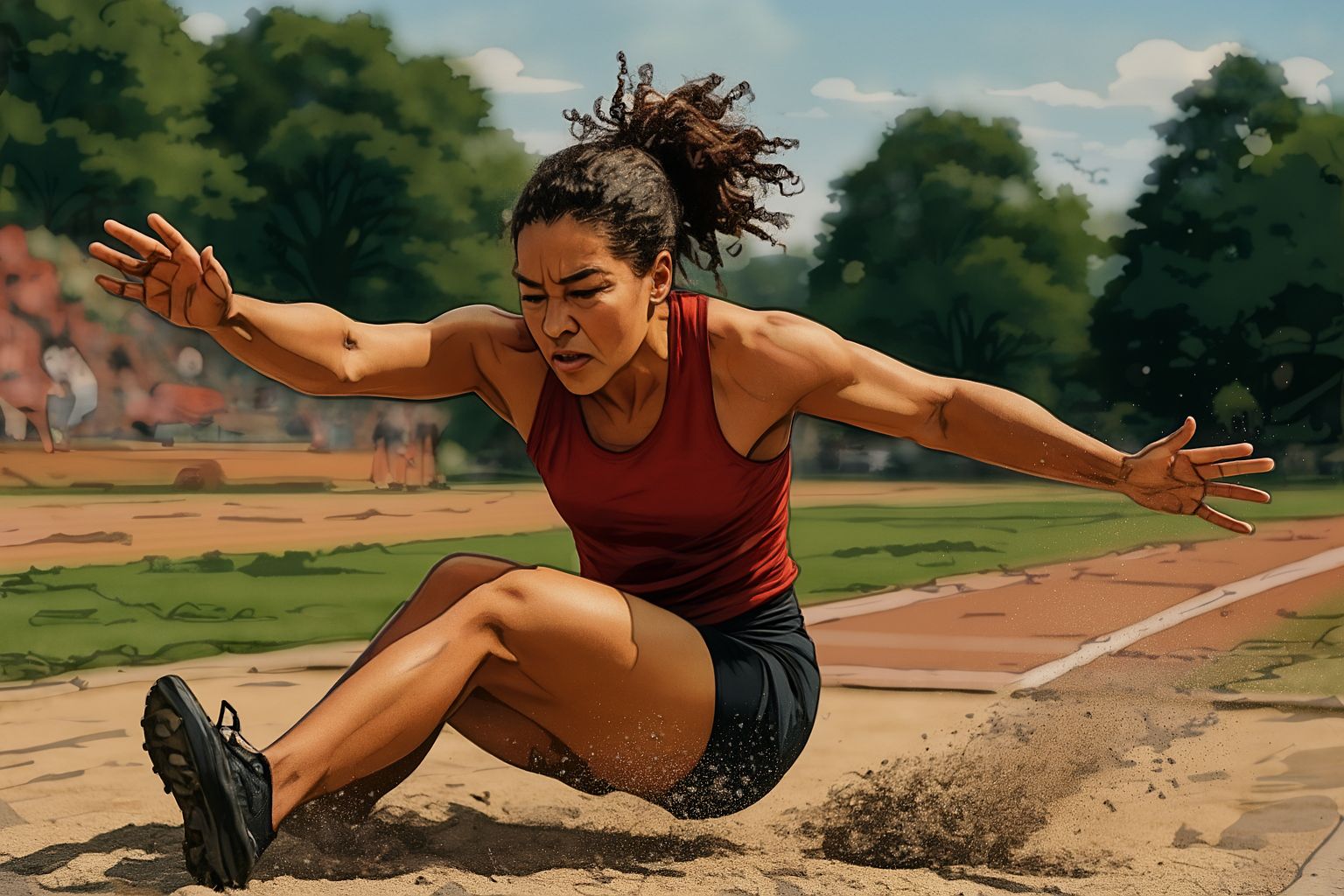Building Power for Throwing Events: Strength Training Essentials
Throwing events in track and field are not just about technique; they also require incredible physical strength, explosive power, and muscular endurance. Whether you’re competing in shot put, discus, javelin, or hammer throw, the foundation of a successful performance starts with strength training. Building the right muscles in the right way will help you generate power, maintain form, and avoid injury.
In this article, we’ll explore the top 10 strength training exercises every athlete in throwing events should incorporate into their training routine. These exercises are designed to enhance your explosive power, improve your grip, strengthen your core, and increase your overall performance. By the end, you’ll have a solid foundation to build your strength and improve your throwing distance.
Understanding the Importance of Strength Training for Throwing Events
Throwing events demand more than just good technique; they require a solid foundation of physical strength and power. Strength training helps athletes improve their ability to transfer energy efficiently from the ground up, through the legs, core, and upper body, and into the throw. Stronger muscles allow for a faster release of the implement (shot, discus, javelin, or hammer) and greater control of the throwing motion.
But it’s not only about building muscle mass—strength training for throwing events is about developing functional strength that translates into power, stability, and endurance during competition. Building a strength training regimen that targets the specific muscles used in throwing events is crucial for maximizing performance.
The Key Muscles for Throwing Events
To understand which exercises are most effective for throwing events, it’s essential to know which muscles are most engaged during the throw. Throwing requires strength from the legs, core, and upper body, with a particular emphasis on the following muscle groups:
Legs: The foundation of every throw starts from the ground up. Strong legs provide the explosive power necessary for a quick, powerful push.
Core: A stable and powerful core allows for efficient force transfer from the lower body to the upper body, which is essential for maintaining proper technique and generating rotational power.
Back and Shoulders: The back and shoulders are critical for controlling the implement and generating the final push during the throw.
Arms and Grip: Strong arms, particularly in the forearms and hands, are essential for holding the implement and ensuring a controlled release.
Now that we understand which muscles need to be developed, let’s dive into the top 10 strength training exercises for throwing athletes.
Deadlifts: The King of Strength Exercises
The deadlift is a foundational strength exercise that builds total body power, especially in the legs, back, and core. This exercise replicates the explosive power and force that athletes need when pushing off the ground during a throw. Deadlifts engage the hamstrings, glutes, quads, and lower back, which are all essential muscles for generating the power required in throwing events.
To perform a deadlift correctly, position your feet shoulder-width apart with the barbell in front of you. Grip the bar with your hands just outside of your knees. Keep your back flat and your chest up as you lift the bar off the ground, pushing through your heels and extending your hips and knees simultaneously. Control the descent of the bar back to the ground. Deadlifts not only build power but also improve overall stability and posture, making them an essential part of any strength training routine for throwing athletes.
Squats: Building Power in Your Legs and Core
Squats are another must-do exercise for throwing athletes. They target the quadriceps, hamstrings, glutes, and core—key muscles for generating explosive power during a throw. The squat also helps build stability in the lower body, which is crucial for maintaining proper posture and balance during the throwing motion.
To perform a squat, stand with your feet shoulder-width apart and lower your body by bending your knees, keeping your chest upright and your back straight. Drop your hips down to parallel or below, depending on your mobility, and then push through your heels to return to the standing position. Variations like front squats, overhead squats, and Bulgarian split squats can further target different areas of the legs and core, making squats one of the most versatile and effective strength exercises for throwing athletes.
Power Cleans: Explosive Power Development
The power clean is a full-body exercise that builds explosive power, a critical component in all throwing events. The movement focuses on rapid acceleration and requires speed, strength, and coordination. Power cleans engage the legs, back, and shoulders, making them one of the best exercises for throwing athletes who need to develop power for quick, explosive movements.
To perform a power clean, start by standing over the barbell with your feet shoulder-width apart. Bend at the hips and knees to grip the bar, then explosively pull the bar up while jumping and shrugging your shoulders. As the bar reaches its highest point, quickly rotate your elbows under the bar and catch it at shoulder height. Power cleans help athletes develop the fast-twitch muscle fibers necessary for generating force during the throw, making them a great exercise for any thrower.
Romanian Deadlifts: Strengthening the Posterior Chain
Romanian deadlifts are a variation of the traditional deadlift that specifically targets the hamstrings, glutes, and lower back. These muscles are crucial for throwing athletes, as they play a significant role in generating the power needed during the throw. The Romanian deadlift also helps improve flexibility in the hamstrings and posterior chain, which can improve your range of motion and prevent injuries.
To perform a Romanian deadlift, start by standing with your feet shoulder-width apart and holding a barbell with a slight bend in your knees. Keeping your back straight, hinge at the hips and lower the bar down toward your shins while maintaining a slight bend in the knees. Once you feel a stretch in your hamstrings, return to the starting position by driving your hips forward. This exercise will strengthen the muscles that are crucial for the transfer of power during the throw.
Overhead Press: Building Shoulder Strength
Shoulder strength is critical for throwing events, especially for the release of the implement. The overhead press is a great exercise for building strength and stability in the shoulders, upper arms, and core. A strong, stable shoulder girdle allows for better control of the throw and improves your ability to maintain proper form throughout the motion.
To perform the overhead press, stand with your feet shoulder-width apart and grip a barbell with your hands slightly wider than shoulder-width. Press the bar upward, extending your arms fully overhead while keeping your core engaged and your back straight. Lower the bar back down to the starting position with control. Overhead presses improve upper body power and shoulder stability, both of which are vital for the final push in the throwing motion.
Russian Twists: Strengthening the Core for Rotational Power
The rotational power required in throwing events comes from a strong and stable core. Russian twists are an excellent exercise for building rotational strength and stability in the abdominals and obliques, which are essential for generating the force needed to propel the implement during the throw.
To perform a Russian twist, sit on the ground with your knees bent and feet flat. Lean back slightly and hold a weight (such as a medicine ball or plate) in front of your chest. Rotate your torso to one side, bringing the weight beside your hip, then twist to the other side. Keep your core engaged throughout the movement, and focus on generating power from your core, rather than relying on your arms. Russian twists will help you build the rotational strength needed to transfer power efficiently during the throw.
Pull-Ups: Upper Body Strength and Grip Development
Pull-ups are a fantastic exercise for developing upper body strength, particularly in the back, shoulders, and arms. Strong upper body muscles are essential for controlling the implement and ensuring a powerful release. Additionally, pull-ups help develop grip strength, which is crucial for holding the shot, discus, javelin, or hammer during the throw.
To perform a pull-up, hang from a pull-up bar with your hands shoulder-width apart and your palms facing away from you. Pull your body upward until your chin surpasses the bar, then lower yourself back down with control. Variations of the pull-up, such as chin-ups or weighted pull-ups, can further target different muscle groups and improve overall strength.
Farmer’s Walk: Building Grip and Core Stability
The farmer’s walk is an underrated exercise that builds grip strength, core stability, and overall body endurance. Carrying heavy weights while walking challenges the grip, forearms, and shoulders, while also engaging the core to maintain stability. This exercise is particularly useful for athletes who need to maintain control over their implements during the throw.
To perform the farmer’s walk, grab a pair of heavy dumbbells or kettlebells and hold them by your sides. Stand tall with your chest up and shoulders back, then walk for a set distance or time while maintaining a firm grip on the weights. Farmer’s walks will build grip strength and core stability, both of which are necessary for a successful throw.
Medicine Ball Slams: Explosive Core Power
Medicine ball slams are an explosive movement that mimics the dynamic power required in throwing events. This exercise strengthens the core, shoulders, and arms while improving overall power and speed. It also helps develop coordination and full-body integration, which is crucial for the fluidity of the throwing motion.
To perform a medicine ball slam, start by holding a medicine ball overhead with both hands. Squat down slightly and then explosively slam the ball into the ground as hard as you can. Follow through by catching the ball as it bounces back up and repeat the movement. Medicine ball slams develop explosive power, which is directly transferable to the throwing motion.
The Final Push: Power and Precision in Every Throw
Strength training is the foundation upon which successful throwing events are built. By incorporating these exercises into your training routine, you’ll build the explosive power, core stability, and overall strength necessary to improve your throwing performance. However, remember that strength alone is not enough—technique, mental focus, and consistency are also key components of success.
Stay dedicated to your training, continue challenging yourself, and watch your strength and throwing performance improve. With the right combination of strength training exercises and consistent practice, you’ll be on your way to throwing farther, faster, and with more power than ever before.




